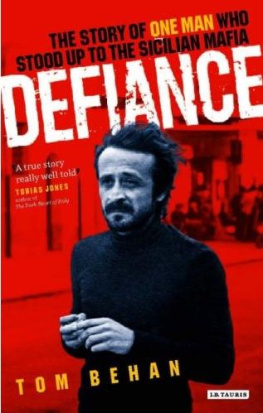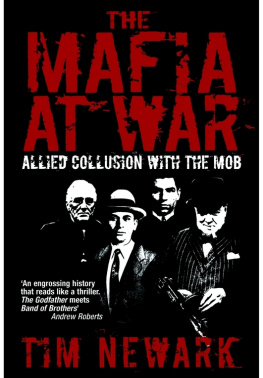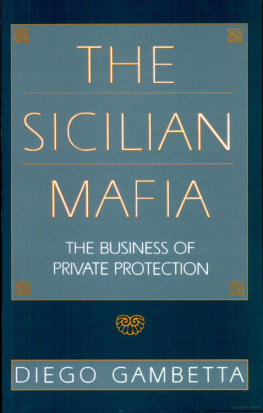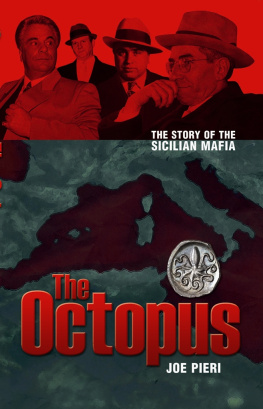The Story of One Man Who Stood Up to the Sicilian Mafia
Tom Behan
Published in 2008 by I.B.Tauris & Co Ltd
6 Salem Road, London W2 4BU
175 Fifth Avenue, New York NY 10010 www.ibtauris.com
In the United States of America and Canada
distributed by Palgrave Macmillan, a division of St Martins Press, 175 Fifth Avenue, New York NY 10010
Copyright Tom Behan 2008
The right of Tom Behan to be identified as author of this work has been asserted by the author in accordance with the Copyright, Designs and Patents Act 1988.
All rights reserved. Except for brief quotations in a review, this book, or any part thereof, may not be reproduced, stored in or introduced into a retrieval system, or transmitted, in any form or by any means, eletronic, mechanical, photocopying, recording or otherwise, without the proior written permission of the publisher.
ISBN 978 1 84511 514 2
A full CIP record for this book is available from the British Library A full CIP record is available from the Library of Congress Library of Congress Catalog Card Number: available
Typeset by JCS Publishing Services Ltd, www.jcs-publishing.co.uk Printed and bound in Great Britain by TJ International, Padstow, Cornwall
Contents
List of Illustrations vii
Illustrations
Illustrations appear between pages 120 and 121
Cinisi, showing the motorway, the main street (the Corso), the airport and the sea
Don Tano Gaetano Badalamenti
Hotel Delle Palme
Felicia Impastato
Peppino Impastato
Threatening letter sent to local activists
A meeting of the Music and Culture group
Front blinds of the Impastato house
Giovanni Impastato
A funeral in Cinisi
A house confiscated from the Badalamenti family, with Mount Pecoraro in the background
A funeral procession on Cinisis main street
Pictures 1, 3, 8, 9 and 11 are the authors photographs. Picture 5 courtesy of Paolo Chirco.
Two Deaths
T
he driver of the midnight train from Palermo stopped the locomotive when he felt a bump on the line. He climbed down and saw the rail was twisted and
broken, but luckily the train hadnt jumped the tracks. It was 1978 and nobody had mobile phones. So he stopped at the next station, Cinisi, where he told the stationmaster what had happened. Oddly, the police were only contacted two hours later.
When they searched the area they quickly saw that about two feet of the track had been destroyed in what looked like an explosion. But the blast hadnt just damaged a stretch of railway line. As the police report written later that morning stated:
A body had been blown to pieces and fragments were spread over a radius of 300 metres. They are described as follows: a piece of the cerebral lobe, bones from the vault of the skull and segments of scalp were all found at a short distance... A piece of bone identified as a segment of the spine... there are loose pieces of tissue everywhere whose original bodily position cannot be identified... a limb, presumably the right thigh-bone... partly covered Defiance
with the remains of blue trousers, and a sock of the same colour on the foot...
About 100 metres from this bone the remains of the left thigh-bone were discovered... spread all around the area, particularly close to the railway line, were fragments of clothing made up of two patterns: a green, brown and grey check; blue material probably belonging to the trousers; blue wool probably belonging to a jumper... Furthermore, on the road-bed adjacent to the line two Dr. Scholl clogs were found...
Four days later, people were still scraping bits of flesh off surrounding bushes and trees.
While the police were writing their report, another murder took place in Rome. Three men took their hostage down into a garage and shot him repeatedly. They then drove the body to the city centre and left the car, phoning the press with the news. This murder was carried out by the Red Brigades, a left-wing terrorist organisation. The man they had killed was Aldo Moro, whom they had kidnapped 55 days earlier. Moro had been elected as Italys Christian Democrat prime minister five times, and was arguably the most powerful politician in the country this is why the Red Brigades kidnapped him. They hoped to gain credibility by negotiating the release of some of their members held in jail in exchange for Moro, or alternatively to obtain large amounts of money through payment of a ransom. When it became clear the government wouldnt negotiate, they killed him. So after a month and a half of anguish, with the Pope even offering to substitute himself as hostage, the huge public crisis came to a tragic end.
Naturally there was wall-to-wall television coverage of Moros death, so the other death earlier that day in Cinisi didnt make it onto television news, and newspapers only commented on it briefly the next day. After all, this was a sleepy town whose only notable feature was the fact that Palermo airport had been built within its boundaries. What apparently connected the two deaths was terrorism; the police quickly said the dead man in Sicily was probably a
TwoDeaths
left-wing terrorist who had been blown up by his own bomb. But what really connected them, or rather what connected Aldo Moro and national politics to the body blown to pieces in a small Sicilian town was the Mafia.
The Killing Fields
W
hen three American tanks drove into the central Sicilian town of Villalba on 20 July 1943, the soldiers immediately asked local people to
call Don Calogero Vizzini for them. Eight days later US Lieutenant Beehr from the Allies civil affairs office presided over a ceremony at the local police station, in which Vizzini became mayor of his home town.
The Allied invasion of Sicily in the summer of 1943 overthrew a dictatorship that had lasted twenty years. Their problem was that opposition to Mussolini and fascism was dominated by Socialists and Communists, whose demands hardly coincided with American plans for postwar Italy. Rather than working with these mass democratic organisations, the Allies turned to a different kind of power structure.
Superficially, Vizzini seemed a very respectable middleaged man, two of his brothers were priests and one of his uncles was a bishop. But a quick look at Vizzinis criminal record during the fascist period illustrated what kind of man he really was: tried for four different murders he had been acquitted each time, although he was convicted of Mafia membership and spent five years in jail. He had also been charged, but not brought to trial, for 39 murders, six attempted murders, 36 robberies, 37 thefts and 63 extortions. Documents written by US agents at the time clearly show that officials knew who the Mafia leaders were indeed Vizzini was probably the leader of the Mafia at the time they therefore had no objection to giving political power to top Mafiosi .
A similar event occurred in the town of Mussomeli, just a few miles away. A new councillor, Giuseppe Genco Russo, had been acquitted of five murders in 1928, four in 1929 and three in 1930, together with three attempted murders; in 1931 he escaped conviction for being a member of a criminal organisation, and in 1932 once again was acquitted of three murders. However, he was convicted of conspiracy to commit a crime in 1932 and served three years of a sixyear sentence.
These appointments were being supervised by Colonel Charles Poletti, the senior allied adminstrator of Occupied Italy. An American businessman from an Italian background, he had been deputy governor of New York State before the war and was also a Freemason. Naturally, Poletti appointed specialised staff, such as his interpreter Vito Genovese, to help him. Apart from being fluent in two languages Genovese had a long criminal record, given the fact he was one of the main bosses of the US Mafia indeed he had fled New York in 1936 to escape several charges of murder.











